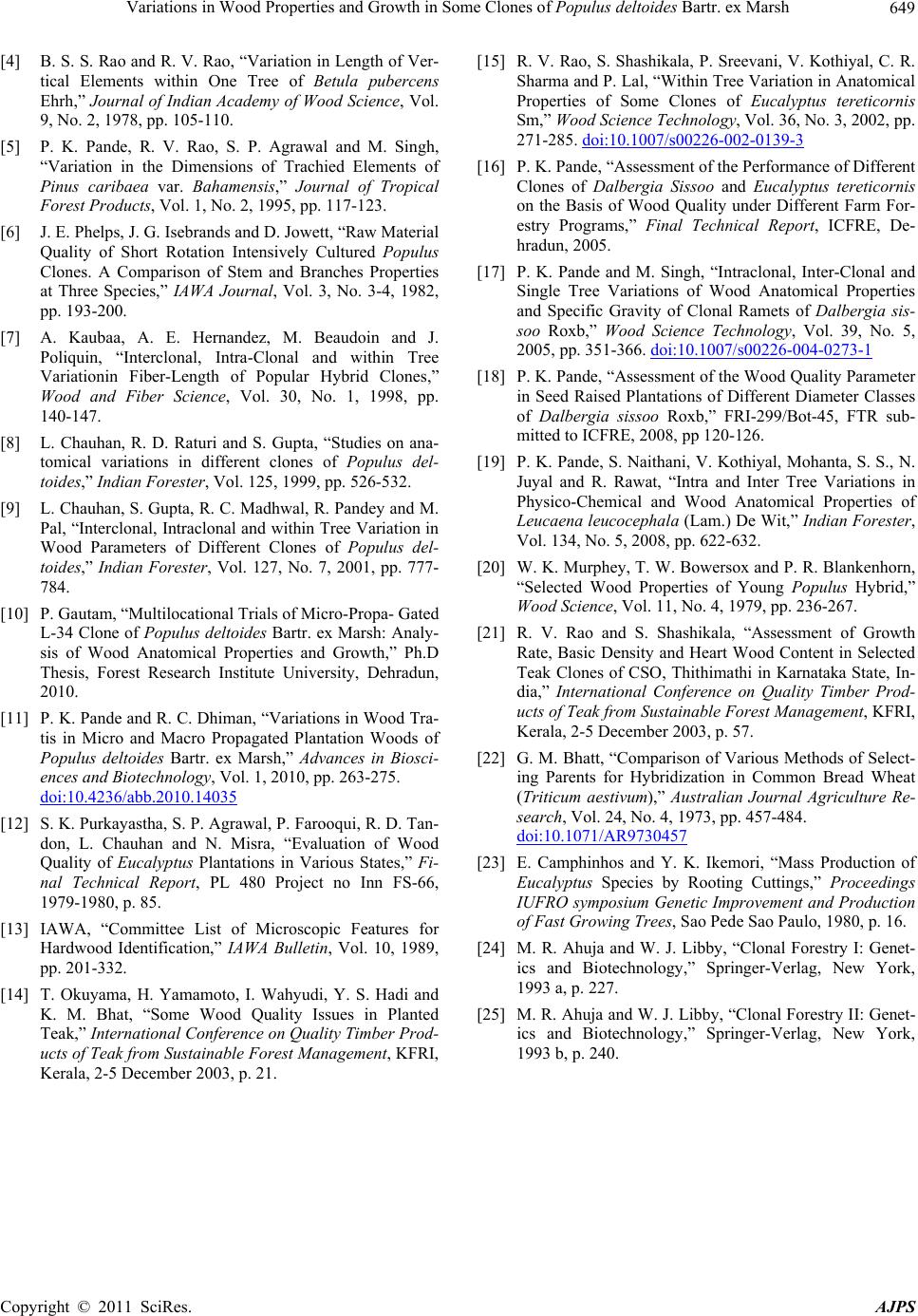
Variations in Wood Properties and Growth in Some Clones of Populus deltoides Bartr. ex Marsh649
[4] B. S. S. Rao and R. V. Rao, “Variation in Length of Ver-
tical Elements within One Tree of Betula pubercens
Ehrh,” Journal of Indian Academy of Wood Science, Vol.
9, No. 2, 1978, pp. 105-110.
[5] P. K. Pande, R. V. Rao, S. P. Agrawal and M. Singh,
“Variation in the Dimensions of Trachied Elements of
Pinus caribaea var. Bahamensis,” Journal of Tropical
Forest Products, Vol. 1, No. 2, 1995, pp. 117-123.
[6] J. E. Phelps, J. G. Isebrands and D. Jowett, “Raw Material
Quality of Short Rotation Intensively Cultured Populus
Clones. A Comparison of Stem and Branches Properties
at Three Species,” IAWA Journal, Vol. 3, No. 3-4, 1982,
pp. 193-200.
[7] A. Kaubaa, A. E. Hernandez, M. Beaudoin and J.
Poliquin, “Interclonal, Intra-Clonal and within Tree
Variationin Fiber-Length of Popular Hybrid Clones,”
Wood and Fiber Science, Vol. 30, No. 1, 1998, pp.
140-147.
[8] L. Chauhan, R. D. Raturi and S. Gupta, “Studies on ana-
tomical variations in different clones of Populus del-
toides,” Indian Forester, Vol. 125, 1999, pp. 526-532.
[9] L. Chauhan, S. Gupta, R. C. Madhwal, R. Pandey and M.
Pal, “Interclonal, Intraclonal and within Tree Variation in
Wood Parameters of Different Clones of Populus del-
toides,” Indian Forester, Vol. 127, No. 7, 2001, pp. 777-
784.
[10] P. Gautam, “Multilocational Trials of Micro-Propa- Gated
L-34 Clone of Populus deltoides Bartr. ex Marsh: Analy-
sis of Wood Anatomical Properties and Growth,” Ph.D
Thesis, Forest Research Institute University, Dehradun,
2010.
[11] P. K. Pande and R. C. Dhiman, “Variations in Wood Tra-
tis in Micro and Macro Propagated Plantation Woods of
Populus deltoides Bartr. ex Marsh,” Advances in Biosci-
ences and Biotechnology, Vol. 1, 2010, pp. 263-275.
doi:10.4236/abb.2010.14035
[12] S. K. Purkayastha, S. P. Agrawal, P. Farooqui, R. D. Tan-
don, L. Chauhan and N. Misra, “Evaluation of Wood
Quality of Eucalyptus Plantations in Various States,” Fi-
nal Technical Report, PL 480 Project no Inn FS-66,
1979-1980, p. 85.
[13] IAWA, “Committee List of Microscopic Features for
Hardwood Identification,” IAWA Bulletin, Vol. 10, 1989,
pp. 201-332.
[14] T. Okuyama, H. Yamamoto, I. Wahyudi, Y. S. Hadi and
K. M. Bhat, “Some Wood Quality Issues in Planted
Teak,” International Conference on Quality Timber Prod-
ucts of Teak from Sustainable Forest Management, KFRI,
Kerala, 2-5 December 2003, p. 21.
[15] R. V. Rao, S. Shashikala, P. Sreevani, V. Kothiyal, C. R.
Sharma and P. Lal, “Within Tree Variation in Anatomical
Properties of Some Clones of Eucalyptus tereticornis
Sm,” Wood Science Technology, Vol. 36, No. 3, 2002, pp.
271-285. doi:10.1007/s00226-002-0139-3
[16] P. K. Pande, “Assessment of the Performance of Different
Clones of Dalbergia Sissoo and Eucalyptus tereticornis
on the Basis of Wood Quality under Different Farm For-
estry Programs,” Final Technical Report, ICFRE, De-
hradun, 2005.
[17] P. K. Pande and M. Singh, “Intraclonal, Inter-Clonal and
Single Tree Variations of Wood Anatomical Properties
and Specific Gravity of Clonal Ramets of Dalbergia sis-
soo Roxb,” Wood Science Technology, Vol. 39, No. 5,
2005, pp. 351-366. doi:10.1007/s00226-004-0273-1
[18] P. K. Pande, “Assessment of the Wood Quality Parameter
in Seed Raised Plantations of Different Diameter Classes
of Dalbergia sissoo Roxb,” FRI-299/Bot-45, FTR sub-
mitted to ICFRE, 2008, pp 120-126.
[19] P. K. Pande, S. Naithani, V. Kothiyal, Mohanta, S. S., N.
Juyal and R. Rawat, “Intra and Inter Tree Variations in
Physico-Chemical and Wood Anatomical Properties of
Leucaena leucocephala (Lam.) De Wit,” Indian Forester,
Vol. 134, No. 5, 2008, pp. 622-632.
[20] W. K. Murphey, T. W. Bowersox and P. R. Blankenhorn,
“Selected Wood Properties of Young Populus Hybrid,”
Wood Science, Vol. 11, No. 4, 1979, pp. 236-267.
[21] R. V. Rao and S. Shashikala, “Assessment of Growth
Rate, Basic Density and Heart Wood Content in Selected
Teak Clones of CSO, Thithimathi in Karnataka State, In-
dia,” International Conference on Quality Timber Prod-
ucts of Teak from Sustainable Forest Management, KFRI,
Kerala, 2-5 December 2003, p. 57.
[22] G. M. Bhatt, “Comparison of Various Methods of Select-
ing Parents for Hybridization in Common Bread Wheat
(Triticum aestivum),” Australian Journal Agriculture Re-
search, Vol. 24, No. 4, 1973, pp. 457-484.
doi:10.1071/AR9730457
[23] E. Camphinhos and Y. K. Ikemori, “Mass Production of
Eucalyptus Species by Rooting Cuttings,” Proceedings
IUFRO symposium Genetic Improvement and Production
of Fast Growing Trees, Sao Pede Sao Paulo, 1980, p. 16.
[24] M. R. Ahuja and W. J. Libby, “Clonal Forestry I: Genet-
ics and Biotechnology,” Springer-Verlag, New York,
1993 a, p. 227.
[25] M. R. Ahuja and W. J. Libby, “Clonal Forestry II: Genet-
ics and Biotechnology,” Springer-Verlag, New York,
1993 b, p. 240.
Copyright © 2011 SciRes. AJPS